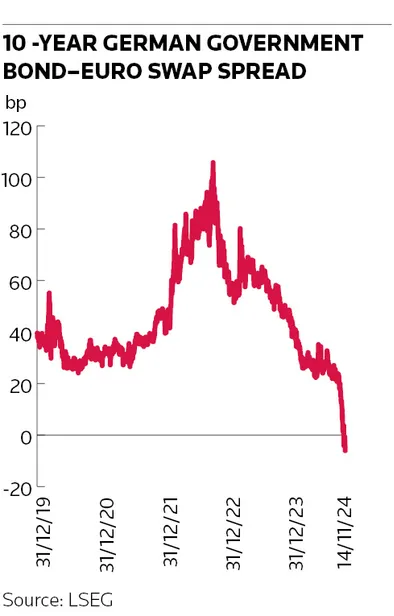New era for German debt as swap spread turns negative
German 10-year bond yields are trading above euro interest rate swaps for the first time in history, a watershed moment for these markets that underlines just how much investors have soured on government debt.
It’s only two and a half years since Germany 10-year yields were hovering below zero, meaning investors were effectively paying for the privilege of owning the country’s bonds. Fast forward to today and yields have jumped across the globe in the wake of rampant inflation and governments running wider fiscal deficits.
That loosening of the purse strings has even extended to Germany, a country renowned for its fiscal rectitude, raising the prospect of an increase in debt issuance to plug budgetary holes. Making matters worse, this expected increase in bond supply is coinciding with a buyers' strike from some crucial investors, including the most prominent player in these markets over the past decade: the European Central Bank.
Those dynamics have contributed to 10-year swap spreads on Europe's main risk-free benchmark sinking into negative territory for the first time, exemplifying a new era of investor indifference towards these once highly sought-after securities.
“There’s been a lower demand for long-dated government bonds as several investors have reduced exposure to the market, including foreign institutions, sovereign wealth funds and – most significantly – from central banks through quantitative tightening,” said Bruno Lettich, head of global rates, markets, at Standard Chartered, who also pointed to increased hedging activity that has pushed swap rates in the other direction.
“This combination of flows has created a supply-demand imbalance between swap and government bond markets,” he said.
Conventional wisdom holds that government bonds should trade at a premium to swaps to account for the higher credit risk involved in facing a bank as a swap counterparty. But market dynamics play an important role too – and have been known to upend this relationship. US Treasury and UK Gilt swap spreads first dipped below zero in the aftermath of the 2008 financial crisis and have since swung in and out of negative territory.
Germany’s bonds had been immune to such pressures thanks to a chronic shortage of these securities in the market during the previous decade. Berlin maintaining a tight grip on spending constrained supply, while the ECB's vast bond-buying stimulus programmes have massively increased demand.
Shifting dynamics
Both those factors have been fading lately though, causing 10-year German swap spreads to plunge from a high of more than 110bp two years ago to minus 6bp on Friday. Germany's coalition government collapsed earlier this month following clashes over chancellor Olaf Scholz's proposals to increase spending to support the flagging economy and provide Ukraine with more aid in its war against Russia. At the same time, the ECB has been preoccupied with lowering inflation from multiyear highs, forcing it to raise interest rates and start to shrink its bond portfolio.
“The Bund/euro swap spread has moved into negative territory because liquidity continues to decline, as the ECB becomes less active in bond markets, while the supply of government bonds looks set to increase significantly in the future,” said Pablo Zaragoza, head of European macro and sovereign strategy at BBVA.
“Germany is unlikely to be as stringent on keeping deficits low as it was in the past. Therefore, the likelihood that more German paper comes to the market has increased,” he said.
The Bund swap spread dipping into negative territory also came in the aftermath of Donald Trump’s victory in the US presidential elections as the prospect of higher government spending – and tighter central bank policy – became more firmly ingrained across global markets. That drove US and UK swap spreads further below zero, showing the renewed aversion from investors for long-dated bonds more broadly.
Repo strains
There have been other factors in Europe driving bonds and swaps apart. Traders report more hedging volumes from corporates managing the interest rate exposure from their bond issuance, as well as pension funds and insurance companies hedging their long-dated liabilities. Those activities are exerting downward pressure on swap rates at the same time that bond yields are rising.
Traders also point to changing dynamics in repo markets thanks to Bunds becoming more readily available, making it cheaper to borrow them through repurchase agreements.
“The cheapening in German [asset swaps] has been stronger than expected, and faster than we had anticipated,” said Camille de Courcel, head of developed market rates strategy for Europe at BNP Paribas, who said the move “appears to be repo-led”.
“As we expect the [net bond] supply backdrop to remain well into positive territory for 2025, we think repo rates should also remain historically cheap,” she said.
Ongoing tensions
Some are concerned that these ongoing tensions could deter buyers – and not just of government bonds. Zaragoza noted that the negative basis has “significantly reduced the allure and attractiveness of covered bonds”.
Bank treasurers may also be less likely to put money into government bonds if the negative basis persists. Many are already sitting on the sidelines as a result of mark-to-market losses they face on bonds they bought when rates were lower.
“There is definitely a risk that this negative basis pushes away from the market some of the bank treasury community,” said Olivier Lecoutre, a senior SSA trader at Natixis CIB. “This could add to the pressure on [European government bonds] that have high funding needs for next year.”
Traders are hoping a stabilisation in these markets could encourage investors, like banks, to return in coming months. Looking further ahead, though, it’s hard to see appetite for long-dated government debt increasing significantly given the outlook for fiscal and monetary policy.
“Fiscal orthodoxy has changed, and global investors are nervous about deficits at 5% and over,” said Lettich. “Central banks cutting rates will help to increase demand but you really need a meaningfully positive yield curve to make long-dated bonds attractive again for investors.”






